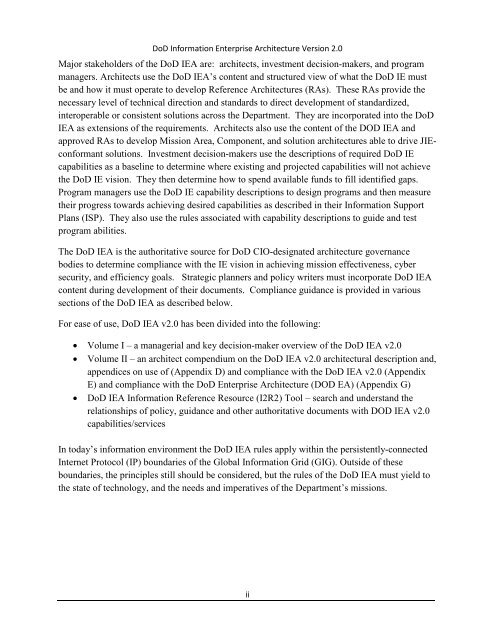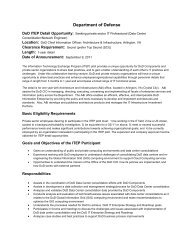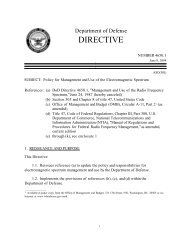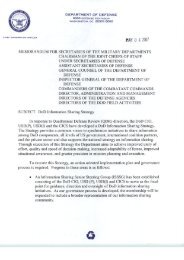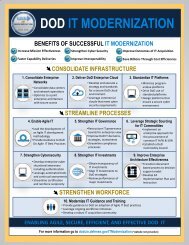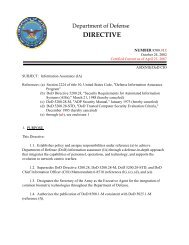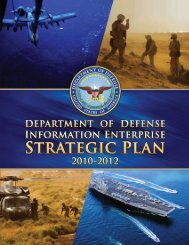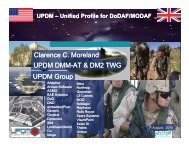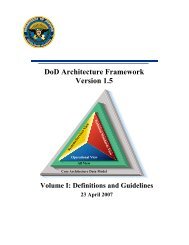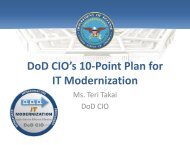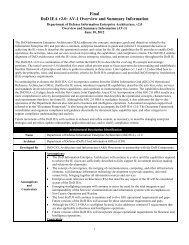DoD IEA v2.0 - Chief Information Officer
DoD IEA v2.0 - Chief Information Officer
DoD IEA v2.0 - Chief Information Officer
You also want an ePaper? Increase the reach of your titles
YUMPU automatically turns print PDFs into web optimized ePapers that Google loves.
<strong>DoD</strong> <strong>Information</strong> Enterprise Architecture Version 2.0Major stakeholders of the <strong>DoD</strong> <strong>IEA</strong> are: architects, investment decision-makers, and programmanagers. Architects use the <strong>DoD</strong> <strong>IEA</strong>’s content and structured view of what the <strong>DoD</strong> IE mustbe and how it must operate to develop Reference Architectures (RAs). These RAs provide thenecessary level of technical direction and standards to direct development of standardized,interoperable or consistent solutions across the Department. They are incorporated into the <strong>DoD</strong><strong>IEA</strong> as extensions of the requirements. Architects also use the content of the DOD <strong>IEA</strong> andapproved RAs to develop Mission Area, Component, and solution architectures able to drive JIEconformantsolutions. Investment decision-makers use the descriptions of required <strong>DoD</strong> IEcapabilities as a baseline to determine where existing and projected capabilities will not achievethe <strong>DoD</strong> IE vision. They then determine how to spend available funds to fill identified gaps.Program managers use the <strong>DoD</strong> IE capability descriptions to design programs and then measuretheir progress towards achieving desired capabilities as described in their <strong>Information</strong> SupportPlans (ISP). They also use the rules associated with capability descriptions to guide and testprogram abilities.The <strong>DoD</strong> <strong>IEA</strong> is the authoritative source for <strong>DoD</strong> CIO-designated architecture governancebodies to determine compliance with the IE vision in achieving mission effectiveness, cybersecurity, and efficiency goals. Strategic planners and policy writers must incorporate <strong>DoD</strong> <strong>IEA</strong>content during development of their documents. Compliance guidance is provided in varioussections of the <strong>DoD</strong> <strong>IEA</strong> as described below.For ease of use, <strong>DoD</strong> <strong>IEA</strong> <strong>v2.0</strong> has been divided into the following:• Volume I – a managerial and key decision-maker overview of the <strong>DoD</strong> <strong>IEA</strong> <strong>v2.0</strong>• Volume II – an architect compendium on the <strong>DoD</strong> <strong>IEA</strong> <strong>v2.0</strong> architectural description and,appendices on use of (Appendix D) and compliance with the <strong>DoD</strong> <strong>IEA</strong> <strong>v2.0</strong> (AppendixE) and compliance with the <strong>DoD</strong> Enterprise Architecture (DOD EA) (Appendix G)• <strong>DoD</strong> <strong>IEA</strong> <strong>Information</strong> Reference Resource (I2R2) Tool – search and understand therelationships of policy, guidance and other authoritative documents with DOD <strong>IEA</strong> <strong>v2.0</strong>capabilities/servicesIn today’s information environment the <strong>DoD</strong> <strong>IEA</strong> rules apply within the persistently-connectedInternet Protocol (IP) boundaries of the Global <strong>Information</strong> Grid (GIG). Outside of theseboundaries, the principles still should be considered, but the rules of the <strong>DoD</strong> <strong>IEA</strong> must yield tothe state of technology, and the needs and imperatives of the Department’s missions.ii


